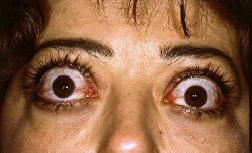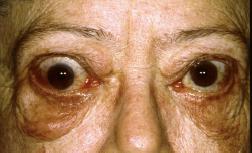Volume 5 • Issue 1
Smoking and Thyroid Disease

by David R. Jordan
M.D., F.A.C.S., F.R.C.S.(C)
INTRODUCTION
Graves disease is a disorder in which the immune system (the natural defense system against disease) mistakenly produces antibodies to the patients own thyroid gland causing it to make more thyroid hormones then necessary [1, 2]. Approximately 10% of patients have associated eye disease. What actually triggers the immune system to malfunction is unknown but many factors are thought to play a role. It seems that both genetic and environmental factors play a role in the development of this disorder [3], and smoking is probably one of the factors capable of inducing Graves disease in genetically predisposed individuals [4, 5]. Among the various clinical features of Graves thyroidopathy, the ophthalmologic manifestations seem to be closely associated with smoking. (Figure 1) Shine et al [6], in questioning patients with Graves disease about their smoking habits, found that there were significantly more smokers in the group with ophthalmopathy than in a control group of healthy subjects. Moreover, patients with severe ophthalmic signs smoked more tobacco than those who suffered from mild ocular disease. The role of smoking in the pathogenicity of different thyroid disorders was studied in a case-control study at the Amsterdam University Hospital [7]. Smoking was found to greatly increase the risk of developing Graves ophthalmopathy and Graves hyperthyroidism. Among patients with Graves ophthalmopathy, smokers had more severe eye disease than non-smokers, but no association was found between the severity of symptoms and the duration of smoking or the number of cigarettes smoked per day. Smoking did not affect other thyroid disorders, such as non-toxic goiter, toxic nodular goiter, or autoimmune hypothyroidism. The results of a prospective study by Pfeilschifter and Zeigler [8] (of 253 patients recently diagnosed with Graves hyperthyroidism) point to current tobacco consumption as a risk factor for the incidence of proptosis and diplopia.

Figure 1– Severe thyroid eye disease in a thirty-two year old female smoker.
HIGHLIGHTS
- Tobacco smoke is composed of as many as 4,000 active ingredients, most of them toxic on either acute or long term exposure and potentially harmful to our health. Many of them are also poisonous to ocular tissue affecting the eye mainly through ischemic or oxidative mechanisms. The list of ophthalmologic disorders associated with cigarette smoking continues to grow (and includes: cataract development, age related macular degeneration, anterior ishemic optic neuropathy).
- several studies have now documented an association between smoking and thyroid disease.
- those with thyroid disease who smoked are more likely to have eye disease,
- thyroid eye disease patients who smoke also have more severe eye disease than nonsmoking thyroid patients.
They also suggest that this risk increases with smoking severity. Similar results were obtained in other studies [4]. Tellez et al [9] confirmed the association between cigarette smoking and Graves ophthalmopathy, but also stressed the relevance of genetic factors, such as ethnic origin, in the development of this disease. The overall risk of developing Graves ophthalmopathy was 6.4 times higher in Europeans than in Asians. After correcting the ethnic factor, the increased risk for Europeans was 2.4 times higher (confidence interval, 1.12-5.18). In a prospective case-control study of 208 patients with newly diagnosed Graves disease [10], the percentage of smokers was higher in the affected group than in the healthy control group. Of 62 patients who had endocrine ophthalmopathy at the time of diagnosis of hyperthyroidism, slightly more patients than control subjects had a history of smoking. Persistent smoking enhanced the severity of eye disease during the course of treatment for hyperthyroidism (Figure 2).

Figure 2– Sixty-two year old male smoker with severe thyroid eye disease.
Tobacco smoking may have a number of effects on the thyroid gland [11, 12]. Tobacco ingredients competitively inhibit iodine uptake and organification (incorporation of iodine into the hormone molecule) in the gland. The influence of cigarette smoking on the sympathetic nervous system (probably through the effect of benzpyrene, a major constituent of tobacco) is also thought to affect thyroid function. Thyroid hormones and thyroid-stimulating hormone-receptor autoantiboties are not affected by smoking, but serum thyroid-stimulating hormone and thyroglobulin levels do show changes in long-term tobacco users. Metcalfe and Weetman [13] studied the possible role of hypoxia in mediating the muscular inflammation that primarily affects extraocular muscle-derived fibroblasts in Graves ophthalmopathy. Their findings indicated that hypoxia can stimulate both protein synthesis and proliferation of extraocular muscle-derived fibroblasts, thereby enhancing the adverse direct effects of smoking on thyroid malfunction.
In summary, tobacco smoking, the leading preventable cause of morbidity and mortality in general, is closely associated with several ocular disorders. Most of the 4,000 active ingredients of tobacco smoke are potentially harmful to our health. The list of ophthalmologic abnormalities linked to this habit is long and continues to grow. Several studies have linked an association between thyroid disease and smoking and it appears that smoking is one of the factors capable of inducing Graves disease in a genetically predisposed individual. Those thyroids that smoke also have more severe eye involvement then those that don’t. Although there is no available data at this stage to show whether stopping smoking by patients with thyroid eye disease will decrease the risk for development or progression of ophthalmopathy, it is probably a good idea (Figure 3).

Figure 3– Fifty-eight year old female smoker with advanced thyroid eye disease.
For more information on the association between Cigarette Smoking and Ocular Disease, see Solberg Y., Rosner M., Belkin M., Survey of Ophthalmology 42:6: 535-547, May-June 1998. The material in this newsletter has been extracted from this article.
References
1. Burch HB, Wartofski L :Graves’ ophthalmopathy: current concepts regarding pathogenesis and managemant. Endocr Rev 14:747-793, 1993.
2. Weetman AP, McGregor AM : Autoimmune thyroid disease:developments in our understandings. Endoc Rev 5:309-355, 1984.
3. DeGroot LJ, Quintans J : The causes of autoimmune thyroid disease. Endocr Rev 10:537-562, 1989.
4. Bartalena L, Martino E, Marcocci C, et al : More on smoking habits and Graves’ ophthalmopathy. J Endocrinol Invest 12:733-737, 1989.
5. Hagg E, Asplund K : Is endocrine ophthalmopathy related to smoking? BMJ 295:644-645, 1987.
6. Shine B, Fells P, Edwards OM, Weetman AP : Association between Graves’ ophthalmopathy and smoking. Lancet 335:1261-1263, 1990.
7. Prummel MF, Wiersinga WM : Smoking and risks of Graves’ disease. JAMA 269:479-482, 1993.
8. Pfeilschifter J, Zeigler R : Smoking and endocrine ophthalmopathy : impact of smoking severity and current vs lifetime cigarette consumption. Clin Endocrinol Oxf 45:477-481, 1996.
9. Tellez M, Cooper J, Edmons c : Graves’ ophthalmopathy in relation to cigarette smoking and ethnic origin. Clin Endocrinol Oxf 36:291-294, 1992.
10. Winsa B, Mandahl A, Karlsson FA : Graves’ disease, endocrine ophthalmopathy and smoking. Acta Endocrinol Copenh 128:156-160, 1993.
11. Bertelsen JB, Hegedus L : Cigarette smoking and the thyroid. Thyroid 4:327-331, 1994.
12. Bertelsen JB, Hegedus L : Cigarette smoking and the thyroid gland Ugesk Laeger 157:4019-4022, 1995.
13. Metcalfe RA, Weetman AP : Stimulation of extraocular muscle fibroblasts by cytokines and hypoxia : possible role in thyroid-associated ophthalmopathy. Clin Endocrinol 40:67-72, 1994
If you have any questions regarding the topics of this newsletter, or requests for future topics of InSight, please contact Dr. David R. Jordan office by telephone at (613) 563-3800.







